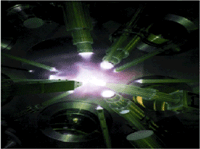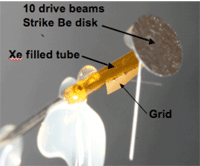The Center for Radiative Shock Hydrodyamics (CRASH) was located at the University of Michigan and was funded by the Department of Energy under the Predictive Science Academic Alliance Program . The purpose of the center was to develop advanced techniques for predictive simulation of multiscale, multiphysics phenomena, and to apply these methods to the problem of radiative shock wave structure and propagation. These shock waves are generated in the laboratory using lasers. The CRASH experiments took place at the Omega Laser Facility associated with the University of Rochester’s Laboratory for Laser Energetics. The target chamber of the facility is shown below.
Intense laser light is focused on a beryllium disk attached to one end of plastic tube filled with xenon gas. The absorption of the intense laser light vaporizes the surface of the beryillium disk and generates a shockwave that propagates into the xenon at a temperature of roughly 1,000,000 degrees Kelvin. The experimental apparatus is shown below.
At these extreme temperatures, the thermal radiation takes the form of x-rays. A shock wave propagating in the xenon is shown below.
CLASS was a partner with the University of Michigan in CRASH. Modeling of radiative shocks requires the coupled solution of the hydrodynamics equations and the radiation transport equation. Faculty, staff, and students members of CLASS contributed to both the numerical methods and the software needed to model the thermal radiation, and contributed to the development and application of methodologies for estimating the uncertainty associated with the overall calculation.





